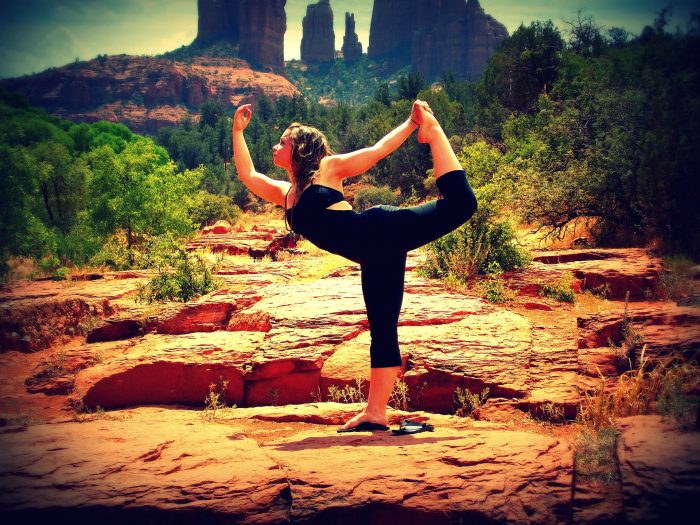One evening, in a group conversation with fellow Ayurveda educators and yoga practitioners, the terms “AyurYoga” and “Ayurveda-Yoga” came up.
One of the doctors was surprised when she learned that there is a special training to incorporate Ayurveda into yoga practices. I am paraphrasing what this doctor said next.
She reiterated that yoga and Ayurveda are an integral part of each other. Ayurveda itself is a yoga, and it works on purifying the mind and body. It is a form of healing. Yoga aims at taking us through self-realization. “How can anyone practice yoga without incorporating Ayurveda?” she quipped. “All yoga teachers must understand the importance and value of the right diet and herbs as yogic tools and Panchakarma to prepare the body for yoga,” she further added.
Her explanation offered a fresh perspective to me—a certified AyurYoga practitioner. I teach yoga while including and honoring Ayurvedic principles. My quest for this combination began when I felt my Vinyasa yoga teacher training left me with some unanswered questions about the impact of certain asanas on people’s mind, moods, and body, including mine. I also noticed how seasons impacted my yoga practice.
Benefits of Integrating Ayurveda and Yoga
I had never thought of yoga and Ayurveda as being part of each other, but it makes a lot of sense. In the west, we refer to them as sister sciences. But studies tell us that without an Ayurvedic view of the body, Hatha yoga is incomplete. And Raja yoga is incomplete without an Ayurvedic understanding of the mind.
Most yoga teacher training programs include some aspects of Ayurveda. But imagine a world where every yoga teacher understood the concept of the five elements (air, ether, fire, water, and earth), three doshas, Gurvadi gunas (10 pairs of opposites that represent the qualities in all things around us), and three Mahagunas (sattva, rajas, and tamas—which are how we relate to circumstances mentally). If they were able to apply Ayurvedic principles into their daily teachings?
For example, consider the season we are in: Kapha. Become aware of the 10 opposing pairs of gunas for the dosha in this season since according to Ayurveda, like increases like. Teaching and practicing yoga asanas with opposite qualities would bring vitiated Kapha back into balance.
What is Kapha Dosha?
Kapha dosha is a combination of earth and water elements. Kapha season starts in late winter and goes on until spring. The main “seat” of Kapha dosha (each dosha has a primary and secondary site in specific parts of the body) is the chest and stomach. And the main qualities of Kapha are heavy, slow, dense, dull, soft, oily, and cold. People are still healing from the pandemic, not making the smartest choices when it comes to diet, many are still working remotely, and, not everyone is moving as much as they used to. Voilà, that’s a sure shot recipe for Kapha imbalance along with the fact that we are in Kapha season.
What does Kapha balancing Yoga practice look like?
Excess Kapha can show up in the body as weight gain, metabolic disorders, and sluggish digestion. In the mind, Kapha vitiation can show up as lethargy, lack of motivation, foggy thinking, unhealthy attachment, and greediness. Because the main sites of Kapha are the lungs, stomach, and sinuses, poses to open the chest are highly recommended. Hold yoga asanas for short periods and let heat build up. Also, do poses that help release mucus from the chest as well as reduce stagnation.
>> For instance, to balance out Kapha’s gross quality, practice more warming, lightening, stimulating, and energizing asanas while avoiding too many static postures.
>> Backbends are great—think Ustrasana (Camel Pose). Urdhva dhanurasana (upward facing bow) is a great option—it is typically more challenging, and it brings more heat/blood flow to the head through gravity, and it opens the chest. Natarajasana (king dancer), and salabhasana (locust) are also great backbends for Kapha. Dhanurasana (Bow Pose) is good for stroking the agni.
>> Inversions are powerful for Kapha as they stimulate circulation and help bring a feeling of lightness to the body. But it’s not advisable if the person is overweight.
>> Surya Namaskar is done to increase warmth and mobility in the body and helps boost the blood circulation.
>> Sitting yoga postures can be effective if they are accompanied by heating breathing techniques as Kapha tends toward inertia.
>> Don’t get comfortable with standing poses—incorporate movement.
>> Twists are great but require mindfulness in breathing as “closed” lungs can increase vata.
Pranayama and Shat Kriya for bringing Kapha back to balance
In Sanskrit “Shat” means six and “Kriya” means internal action; these are the main cleansing techniques used in yoga (sometimes called “shat karmas,” also meaning the “six actions” of cleansing). Pranayama is often translated as breathing techniques. Below is a list of Shat Kriyas and Pranayama recommended for lowering Kapha. They also remove stagnation of doshas.
Bhastrika (Bellows Breath): This pranayama drains excess phlegm from the lungs. It also builds heat in the body to mobilize mucus. Kapha imbalance can bring a quality of “dullness” with it. This pranayama energizes the body and mind.
Kapalabhati (Skull Shining Breath): This Kriya consists of short, powerful exhales and gentle inhales. The exhalation is active, and the inhalation is passive. The basic idea behind Kapalbhati is that the brain and all parts of the skull are cleansed through short but strong exhalations of air.
This shat kriya is an energizing, cleansing practice that clears the lungs, the nasal passages, and the mind. It also supports immunity.
Surya Bhedana: This is a yoga breathing technique that generates heat, energy, and activates the “masculine” functions by stimulating the Pingala Nadi—the solar energy channel. It helps clear sinuses. It improves metabolism, aids in weight loss, and increases the efficiency of the digestive system. A Kapha imbalance often involves sluggish digestion.
Agni sara (fire essence pranayama): It is considered a traditional kriya, or yogic cleansing practice that tones the abdominal muscles. It also fuels the inner fire, stokes digestion, promotes elimination, clears the mind, and activates prana.
Walking Meditation for Kapha
Sitting for prolonged periods, even for the benefit of meditation, might encourage laziness and unhealthy attachments. The best meditation technique, walking, is one that has the opposite qualities of Kapha: light, mobile, lively, and energizing. Walk anywhere for 15-20 minutes and notice how that feels. It is a great way to combine breath and movement.
As you can tell, yoga and Ayurveda are inseparable. But before you start doing any kind of asanas practice, shat kriya, pranayama, or meditation, may I suggest that you work with an experienced yoga and Ayurveda teacher? There are contraindications for many of these practices. If done incorrectly, there is also a chance of injury.
“As long as we are not living in harmony with nature and our constitution, we cannot expect ourselves to be really healed. Ayurveda gives us the means.” ~ David Frawley
~












Read 5 comments and reply